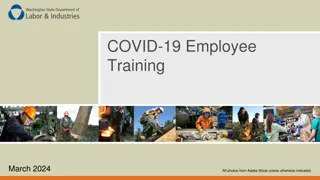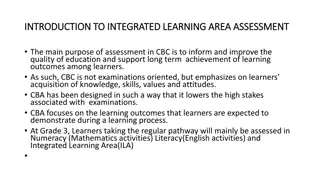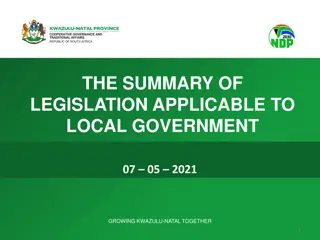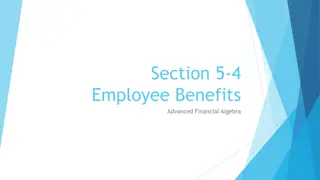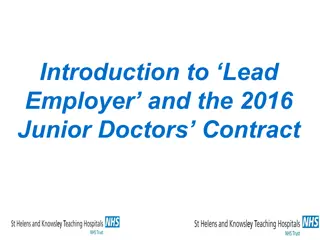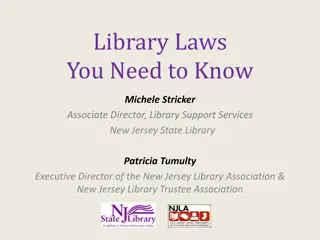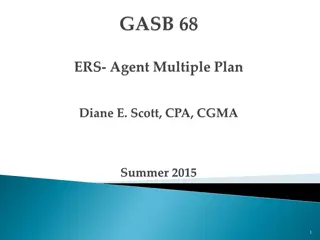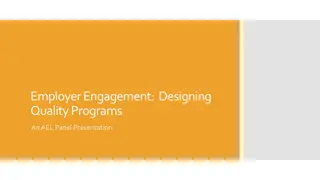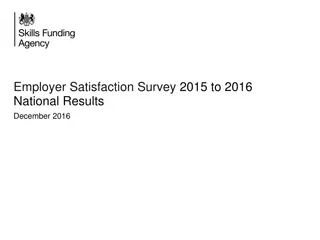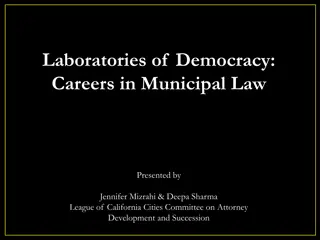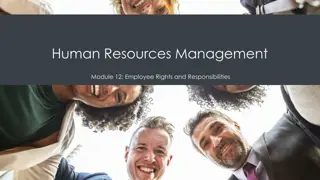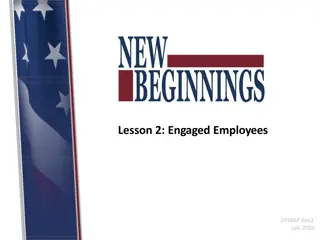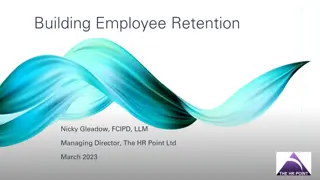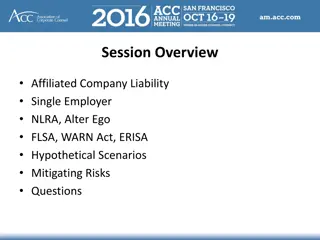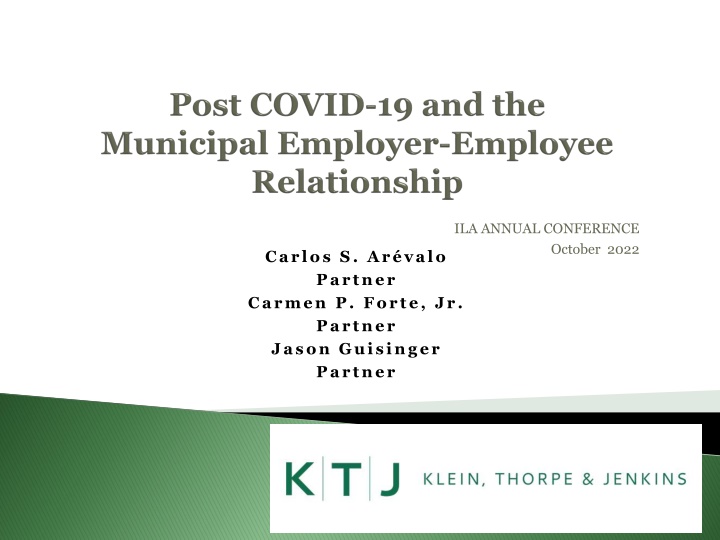
Insights into Hiring Challenges, Labor Market Trends, and Resignation Impact
Discover the effects of the pandemic on the workforce, the rise of the Great Resignation phenomenon, and the implications for job seekers and employers. Explore statistics on unemployment rates, salary changes, and employee sentiments towards work environment pressures and financial concerns. Learn about the differences between private and public sector employment opportunities and the factors affecting talent retention in the current job market landscape.
Download Presentation

Please find below an Image/Link to download the presentation.
The content on the website is provided AS IS for your information and personal use only. It may not be sold, licensed, or shared on other websites without obtaining consent from the author. If you encounter any issues during the download, it is possible that the publisher has removed the file from their server.
You are allowed to download the files provided on this website for personal or commercial use, subject to the condition that they are used lawfully. All files are the property of their respective owners.
The content on the website is provided AS IS for your information and personal use only. It may not be sold, licensed, or shared on other websites without obtaining consent from the author.
E N D
Presentation Transcript
ILA ANNUAL CONFERENCE October 2022 Carlos S. Ar valo Partner Carmen P. Forte, Jr. Partner Jason Guisinger Partner
Hiring challenges and the labor market post- pandemic Impact of COVID-19 and the return of the workforce, continuing effects Trends and practical issues Best practices and policies Questions
The Great Resignation Significant for all employment sector, including the public sector Delays in re-entry into workplace Applicants going through the motions Childcare Schools were virtual Childcare availability reduced People opted out of the work force Early retirements Fear of working in forward facing positions Changing priorities Looking for better work/life balance
February 2020 3.5% unemployment April 2020 14.7% unemployment June 2022 3.6% unemployment 95% of jobs lost due to pandemic have been replaced Median salary increases 3.0 t0 3.4% Inflation rates: June 2020 .646% June 2021 5.391% June 2022 9.060%, highest in over 40-years
According to a recent Deloitte survey focusing on Gen Z and millennial workers: 46% of Gen Zs and 45% of millennials feel burned out due to the intensity/demands of their working environments. 44% of Gen Zs and 43% of millennials say many people have recently left their organization due to workload pressure. Almost half of Gen Zs (46%) and millennials (47%) live paycheck to paycheck and worry about covering expenses. More than a quarter of Gen Zs (26%) and millennials (31%) worry they may not be able to retire comfortably.
Impacts from the Great Resignation Attracting and retaining talent Avoiding burnout Dealing with what some call the Great Retirement Inexperienced managers Too green Too busy Too torn
Private sector employees typically receive more opportunities for job advancement because the decision is based on their performance. In terms of payment, private sector employees have more opportunities for pay raises and higher salaries than their public sector counterparts. No income caps Promotions based on work performance, not steps or grades. The private sector offers greater diversity in job opportunities and more options. *indeed.com
Public sector typically more stable due to less need to meet market pressures. Job security. Comprehensive benefits packages. These benefits may include health insurance and retirement benefits. This advantage can make it easy for such employees to move amongst different public sector jobs while retaining similar benefits. Serving the community and improving the lives of others. * indeed.com
Expect employees (current and future) to make demands regarding: Terms and conditions of employment Policies impacting employees health, infectious diseases, protocols Flexibility Remote/hybrid work Alternative schedules Fair and competitive wages Benefits Work life balance Autonomy Diversity, Equity and Inclusion
No longer the standard Sick Leave policy (may need to take a look at what s in the handbook) Some new elements: Expansion of sick days (paid and unpaid) Sick banks/employee sharing Cash outs Doctor s notes Infectious disease protocols Vaccinations Confidentiality Standby applicable policies FMLA, ADA, etc. CBAs
The policy and purpose: T0 protect the workplace in the event of an infectious disease outbreak. To continue operating effectively. To ensure that all essential services are continuously provided. To establish guidelines. To keep employees are safe within the workplace. To be flexible and adjust to mandates or recommendations issued by the Centers for Disease Control and Prevention ( CDC ) and/or the Illinois Department of Public Health ( IDPH ).
The safeguards Allow employees to recover from illness and/or to care for loved ones. Implementing measures that will protect employees wages, benefits, security in such circumstances Avoid OSHA claims. State of readiness what s your contingency plan. Proactive v. reactive measures Don t want to be caught unprepared
Family and Medical Leave Act (FMLA) Initially passed in 1993 Revised in 2009 and again in recent years Became critical during pandemic Basic concept: Employees who have worked for employer for at least 12 months and at least 1,250 hours during the prior 12 months may be eligible to take up to 12 weeks of unpaid leave in a 12-month period. Will you need to consider supplementing statutory requirements Municipalities are covered without regard to number of employees.
For a serious health condition that makes the employee unable to perform essential functions of the job. To care for a spouse, child, or parent who has serious health condition. The birth of a child or placement of child with the employee for adoption or foster care.
Yes, Inpatient care Incapacity for more than 3 days with continuing treatment Pregnancy/prenatal care Permanent or long term incapacity Certain conditions with multiple treatments No, Colds and flu Earaches Upset stomach, ulcers Headaches (other than migraines) Routine dental, orthodontic, periodontal disease Cosmetic treatment, unless complications arise or inpatient care is required
Intermittent care Substitution of paid leave employers may require use of paid leave to run concurrently Re-employment Equivalent position Equivalent pay No waiver of rights Light duty acceptance does not waive job restoration
In 2008, the Americans with Disabilities Act Amendments Act (ADAAA) was signed into law and became effective on January 1, 2009. The ADAAA made a number of significant changes to the definition of disability. The changes in the definition of disability in the ADAAA apply to all titles of the ADA, including Title I regarding employment practices of private employers with 15 or more employees, state and local governments, employment agencies, labor unions, agents of the employer and joint management labor committees.
Title I is designed to help people with disabilities access the same employment opportunities and benefits available to people without disabilities. Employers must provide reasonable accommodations to qualified applicants or employees. A reasonable accommodation is any modification or adjustment to a job or the work environment that will enable an applicant or employee with a disability to participate in the application process or to perform essential job functions.
Title I: defines disability, establishes guidelines for the reasonable accommodation process, addresses medical examinations and inquiries, and defines direct threat when there is significant risk of substantial harm to the health or safety of the individual employee with a disability or others.
Long COVID effects according to CDC: Post-COVID conditions can include a wide range of ongoing health problems; these conditions can last weeks, months, or years. Post-COVID conditions are found more often in people who had severe COVID-19 illness, but anyone who has been infected with the virus that causes COVID-19 can experience post-COVID conditions, even people who had mild illness or no symptoms from COVID-19. People who are not vaccinated against COVID-19 and become infected may also be at higher risk of developing post-COVID conditions compared to people who were vaccinated and had breakthrough infections. While most people with post-COVID conditions have evidence of infection or COVID-19 illness, in some cases, a person with post-COVID conditions may not have tested positive for the virus or known they were infected. CDC and partners are working to understand more about who experiences post-COVID conditions and why, including whether groups disproportionately impacted by COVID-19 are at higher risk.
General symptoms Tiredness or fatigue that interferes with daily life Symptoms that get worse after physical or mental effort (also known as post-exertional malaise ) Fever Respiratory and heart symptoms Difficulty breathing or shortness of breath Cough Chest pain Fast-beating or pounding heart (also known as heart palpitations) Neurological symptoms Difficulty thinking or concentrating (sometimes referred to as brain fog ) Headache Sleep problems Dizziness when you stand up (lightheadedness) Pins-and-needles feelings Change in smell or taste Depression or anxiety Digestive symptoms Diarrhea Stomach pain Other symptoms Joint or muscle pain Rash
Under the ADA, an employee with a disability must be given reasonable accommodations that enable them to perform the essential functions of their job, unless doing so would pose an undue hardship (significant difficulty or expense) to the employer. Reasonable accommodations may be made. In all cases where an employee's disability prevents them from being vaccinated, employers must engage with the employee in the "interactive process" to arrive at a reasonable accommodation. Similarly, under Title VII of the Civil Rights Act of 1964, an employee whose sincerely held religious belief, practice, or observation prevents them from getting vaccinated must also be provided a reasonable accommodation, unless doing so would pose an undue hardship ("more than de minimis cost") to the employer. If employees are represented by a union, employer has a duty to bargain with the union over the implementation of a mandatory vaccination policy.
The Occupational Disease Act states: A disease shall be deemed to arise out of the employment if there is apparent to the rational mind, upon consideration of all the circumstances, a causal connection between the conditions under which the work is performed and the occupational disease. The disease need not to have been foreseen or expected but after its contraction it must be apparent to have had its origin or aggravation in a risk connected with the employment to have flowed from that source as a rational consequence. 820 ILCS 310/1(d) Nothing in statute requires direct proof of causation Causation may be based on a medical expert s opinion that an accident could have or might have caused an injury not so easy A chain of events suggesting a causal connection may suffice to prove causation even if at the outset the disease is unknown.
Safeguarding employees confidential health information. Information collected in any screening process must be kept confidential. Policies should include privacy components addressing collection, use, storage, and retention of any data collected from screening measures. Proof of vaccination or other health measures.
CBAs typically supplement leave available under state or federal law by providing the following: Sick leave Vacation Personal days Holidays Compensatory time Military leave Other as defined by CBA
The emergence of the remote/hybrid workplace: Only some positions Flexible work arrangements Alternating days on/days off with peers Equitable arrangements One size does not fit all
Pros Reduces work space footprint Increases employee retention Reduces of work- related stress, negative emotions Increases in productivity Cons Non-stop work Inability to separate work and home life Isolation Distractions Unaccountability Reduction of team work attitudes. *The Future of Work: Exploring the Post-Pandemic Workplace from an Employment Law and Human Resource Perspective, Isaac Mamaysky, UC Davis Business Law Journal, Volume 21, Issue 2 (2020-2021).
Practical issues and challenges: Tracking hours worked for non-exempt employees are paid for all the time actually worked, including overtime Rest period requirements Applicable policies (employment policies still apply!) Remote work agreements Costs and reimbursement of expenses - equipment Training Work hours Temporary v. permanent
Honor system clocking in Using time tracking apps Timely Connecteam Jibble Hourstracker Tracking not just hours, but productivity Balance employer s interests and employee privacy Will I be able to measure and evaluate performance? Bargaining issue what does CBA say?
Working hours, attendance and availability Communications Performance expectations Use of equipment Privacy and data protection Workplace behavior policies EEO and discrimination Anti-harassment policies Discipline and other general rules Bottom line: The employee handbook!
Whos eligible? Availability Time to respond/communication Performance Equipment (personal or employer issue) Partial reimbursement of internet costs, paper, and purchases Tech support issues Right to terminate arrangement - duration Physical environment (home office) Confidentiality
Insofar as any remote working arrangement impact terms and conditions of employment, all issues may be the subject of bargaining: Notice to union regarding arrangement Opportunity to offer input and bargain terms Incorporate CBA terms into arrangement Side letters/memoranda
Another approach the 4-day week! A pilot program* that has seen the following results in some private sector industries: Increased revenues Increased productivity Reduced burnout Happier employees But would it work in public sector? Not all departments? Cause friction between various disciplines * https://www.npr.org/2022/07/06/1109316972/more-companies-are-trying-out-the- 4-day-workweek-but-it-might-not-be-for-everyon
Perceived downsides: Scheduling challenges Difficulty unplugging and plugging back in Task continuity Potential increases in pressure to perform/produce same work as before in less time/hours Not true flexibility, but simply implementing a smaller work week
Compliance with statutory requirements Binding wage tables is CBA Budget limitations Conducting audit/comparability studies of the competition If not wages, consideration of other perks and benefits Training Educational CPI and inflation considerations Signing bonuses Reimbursements
In progress even before the pandemic, but suffered some setbacks as a result of pandemic: Women who s ended up leaving the workplace to take care of the kids? Black and brown and LGBTQ workers taking a relatively higher and more adverse impact Budgets reduced to address DEI
COVID is providing us with an opportunity to spotlight the pre-existing social inequities that have been exacerbated by a health crisis. And so these inequities existed pre- COVID, but they're moment, and giving us reason to do more. amplified in this Ritu Bhasin, Author and Globally Recognized Expert on Inclusion
Creating a diverse and inclusive workforce is an imperative in today s society Benefits Wider talent pool Plug skills gaps Addresses long term and disproportionate adverse economic impacts on certain groups Recruitment Retention
Provide clear information on the employers position with respect to these issues Carefully balance employer/employee interests and consider legitimate operational, security and safety concerns Craft clear and thoughtful policies Explain purpose Explain consequences Craft policies with narrow scope
Analyze and avoid legal challenges prior to implementation: Focus on legitimate operational purposes Apply policies consistently Incorporate procedural safeguards Keep up with legal changes and developments Provide notice, attempt employee/union buy-in, consent Training and education
Carlos S. Arvalo csarevalo@ktjlaw.com (312) 984-6431 Carmen P. Forte, Jr. cpforte@ktjlaw.com (312) 984-6435 Jason A. Guisinger jaguisinger@ktjlaw.com (312) 984-6462

